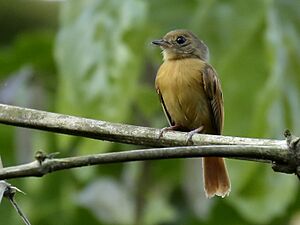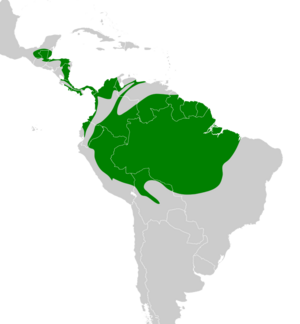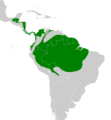Ruddy-tailed flycatcher facts for kids
Quick facts for kids Ruddy-tailed flycatcher |
|
|---|---|
 |
|
| at Rio Branco, Acre state, Brazil | |
| Conservation status | |
| Scientific classification | |
| Genus: |
Terenotriccus
|
| Species: |
erythrurus
|
 |
|
The ruddy-tailed flycatcher (Terenotriccus erythrurus) is a small bird. It belongs to a group called passerines, which are often called "perching birds." This means they have feet made for gripping branches. This flycatcher is part of the Tityridae family.
You can find this bird in warm, low-lying areas. Its home stretches from southeastern Mexico all the way to northern Bolivia, central Brazil, and the Guianas. It lives both east and west of the Andes mountains. East of the Andes, it covers the entire Amazon Basin. West of the Andes, it lives in Colombia, Ecuador, and Central America. It is the only bird in its specific group, called a genus, named Terenotriccus. Some experts used to think it belonged to another group, Myiobius. But the ruddy-tailed flycatcher sings, acts, and looks different from those birds.
Contents
About the Ruddy-tailed Flycatcher
This tiny bird is about 9 to 10.2 centimeters (3.5 to 4 inches) long. It weighs around 7 grams (0.25 ounces), which is very light! Its top feathers are a mix of grey and olive green. It has a reddish-brown rump, tail, and wings. You might also notice a reddish ring around its eyes.
Its throat is a light, creamy color. The chest is a warm cinnamon color, which fades to a pale cream on its belly. Male and female ruddy-tailed flycatchers look very similar. Young birds, however, are brighter in color on top. They also have a browner tail and chest.
What Does It Eat?
The ruddy-tailed flycatcher mostly lives alone. It only sometimes joins groups of different bird species that are looking for food together. This bird loves to eat insects. It especially enjoys leafhoppers. It finds its food by picking insects off leaves. It can also catch them in the air with amazing acrobatic moves!
Sounds and Calls
This flycatcher has a special call that sounds like "see-oo see." It also has a song that repeats "eek eek eek eek eek." Sometimes, when it flicks its wings up, you might hear a soft whirring sound.
Reproduction and Life Cycle
This small flycatcher builds its nest in wet mountain forests. It also likes tall, new growth areas nearby. It nests from sea level up to about 1,000 meters (3,300 feet) high. Sometimes, it nests even higher, up to 1,200 meters (3,900 feet).
The nest is shaped like a pear. It is made from plant fibers and leaves. It has a special side entrance that looks like a small visor. The female bird builds the nest. She hangs it from a twig or vine, usually 2 to 6 meters (6.5 to 20 feet) high in the plants below the trees.
The female lays two white eggs. These eggs have chocolate-colored spots. She sits on the eggs to keep them warm, a process called incubation. This lasts for about 15 to 16 days until the chicks hatch. The male bird does not help with the eggs or the young birds.
Images for kids




